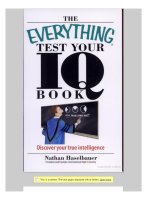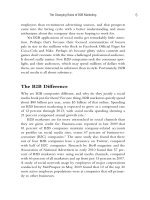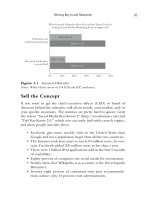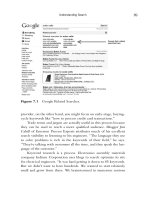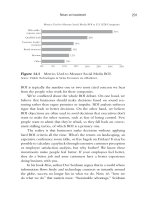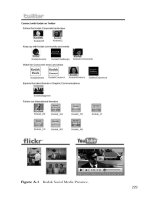THE APTITUDE TEST WORKBOOK: Discover your potential and improve your career options with practice psychometric tests
Bạn đang xem bản rút gọn của tài liệu. Xem và tải ngay bản đầy đủ của tài liệu tại đây (1.67 MB, 206 trang )
i
THE APTITUDE
TEST WORKBOOK
ii
JIM BARRETT
Revised edition
THE APTITUDE
TEST WORKBOOK
London and Philadelphia
Discover your potential and improve
your career options with practice psychometric tests
iii
iv
First published in Great Britain in 2004
Reprinted 2004, 2005, 2007 (twice)
Revised edition 2008
Apart from any fair dealing for the purposes of research or private study, or criticism or
review, as permitted under the Copyright, Designs and Patents Act 1988, this publication
may only be reproduced, stored or transmitted, in any form or by any means, with the prior
permission in writing of the publishers, or in the case of reprographic reproduction in accor-
dance with the terms and licences issued by the CLA. Enquiries concerning reproduction
outside these terms should be sent to the publishers at the undermentioned addresses:
120 Pentonville Road 525 South 4th Street, #241
London N1 9JN Philadelphia PA 19147
United Kingdom USA
www.koganpage.com
© Jim Barrett, 2004, 2008
The right of Jim Barrett to be identified as the author of this work has been asserted by him in
accordance with the Copyright, Designs and Patents Act 1988.
ISBN 978 0 7494 5237 7
British Library Cataloguing in Publication Data
A CIP record for this book is available from the British Library.
Library of Congress Cataloging-in-Publication Data
Barrett, Jim.
The aptitude test workbook : discover your potential and improve your career options
with practice psychometric tests / Jim Barrett. — rev. 1st ed.
p. cm.
ISBN 978-0-7494-5237-7
1. Vocational interests—Testing. 2. Occupational aptitude tests. 3. Vocational
guidance. I. Title.
HF5381.5.B26 2008
153.9Ј4 dc22
2008010355
Typeset by Saxon Graphics Ltd, Derby
Printed and bound in Great Britain by MPG Books Ltd, Bodmin, Cornwall
Whilst the author has made every effort to ensure that the content of this book is
accurate, please note that occasional errors can occur in books of this kind. If you suspect
that an error has been made in any of the tests included in this book, please inform the
publishers at the address printed below so that it can be corrected at the next reprint.
Contents
Introduction 1
1 Verbal tests 8
Test 1: Word skills 10
Test 2: Verbal concepts 24
Test 3: Critical application 33
2 Numerical tests 43
Test 4: Number skills 46
Test 5: Numerical reasoning 57
Test 6: Number logic 63
3 Perceptual tests 71
Test 7: Perceptual logic 72
Test 8: Perceptual deduction 87
Test 9: Power focus 101
4 Spatial tests 115
Test 10: Shapes 116
Test 11: Blocks 123
Test 12: Design 131
v
5 Practical tests 139
Test 13: Word order 140
Test 14: Numerical systems 151
Test 15: Graphs, tables and charts 161
Test 16: Memory 171
6 Interpreting your test results 181
Your aptitude profile 181
Your career potential 186
Further reading from Kogan Page 193
Contents
vi
1
This book contains tests of a psychological type. They will be of interest to
people who want to practise tests in order to gain greater awareness of their
aptitudes and abilities, or to prepare for ‘real test’ situations. The tests are
representative of many tests used for academic, assessment, recruitment or
selection purposes, and will help you to:
• get into the ‘way of thinking’ that is required when taking tests;
• see where you may be able to improve key skills;
• gain awareness of strengths and where they can take you.
The inclusion of two new psychological tests makes this revised edition
even more comprehensive. The new tests of Word Skills and Numerical
Skills are longer and have a wider range than the tests they replace. They
are typical of the tests that are used for selection and assessment purposes
in order to reveal what standard has been attained by a candidate. They
are used as assessments for further training or as criterion measures for
certain jobs where specific skills are required.
Aptitudes and abilities
Most organizations as well as many educational institutions use some
form of psychological testing as part of their selection or employment
Introduction
procedure. Testing has become routine because it is often perceived as
essential, even though there may exist evidence of prior learning (school,
college or professional qualifications) or previous experience (job record
and other attainments). The main reasons are:
• to give an indication of long-term potential for a course, training
or job;
• to give up to date information;
• to provide data that is relevant and fair.
Employers and educational bodies are in a position to compare people’s
performance on tests with other measures of success. For these reasons
what tests seek to discover is:
• What can you do now – have you got the ability?
• What potential have you – have you got the aptitude?
This workbook has a comprehensive range of tests of the types commonly
presented to intending students and job applicants.
‘Real test’ situations
Preparation is not ‘cheating’. Far from it, because if you are not prepared
you may not properly show people what you are capable of achieving. Too
many people appear to ‘fail’ tests for all the wrong reasons, such as:
• not knowing what was expected;
• feeling nervous;
• not understanding the instructions;
• never having seen anything like that before;
• not knowing whether it was possible to ask a question.
There is no shame in failing something you really cannot do, but it is a
waste to fail at something you can. You may have missed the opportunity
of your lifetime, and this may well be a loss to other people as well.
To give yourself the best chance possible, prepare yourself well in
advance. If you have used this workbook, you will have gained plenty of
The aptitude test workbook
2
experience of what you are likely to meet when it comes to ‘the real thing’.
In addition, make sure that you do not let yourself in for any surprises.
Therefore, before you even approach any test situation you should:
• Ask exactly why you are taking the test and what it is for.
• Ask how the results will be used and whether you will get the
results.
• Ask what the test consists of, how long it takes and whether
there is any practice material you can look at.
• Make sure you are comfortable and ready to take a test. You must
not feel any unnecessary stress, either physical or mental.
• Wear clothes that are appropriate to the situation and check
whether you are expected to provide any materials or anything
else yourself.
Getting into the ‘way of thinking’
when taking tests
The tests in this book are representative samples of tests, but tests, like the
people who take them, come in all shapes and sizes. What they all have in
common is a requirement for discipline and attention. You can take your
time and study the tests in your own way. Each is presented as a ‘real’ test
in the way you would see it in a real test situation. Therefore, you are likely
to get most from the tests in this book if you work through them as if you
were taking them for real. This involves timing yourself and completing
them exactly in the way that would be asked of you if you were in ‘exami-
nation conditions’. In any test situation:
• Give yourself plenty of time before the test starts and whilst
looking through instructions.
• Do not be afraid to ask questions (this often helps others as much
as you).
• Always work through practice examples. Take your time and
make sure you thoroughly understand the process.
Introduction
3
• Do not start until you are ready. Do not be frightened of ‘holding
others up’ or that you may look stupid by requiring extra time to
make sure you understand.
• Work as quickly as you can.
• Be accurate (this is more important than trying to get to the end
of the test).
• Do not guess (it is better to move to the next question).
Up to the moment the test actually commences you owe it to yourself to
do everything you can to reduce any uncertainty you may feel.
See where you may be able to improve
key skills
In working through the tests in this volume you will gain from becoming
familiar with different types of test, and from putting yourself in an exam-
ination situation so that it becomes almost routine, and apprehension
about taking tests wears off. This is as far as you can reasonably expect to
go with some of the abstract tests, because you cannot learn how to do
them in the same way as you can learn how to multiply in arithmetic.
However, some of the tests do require specific skills. These include:
• knowledge of words;
• spelling ability;
• knowing how to interpret graphs;
• familiarity with the rules of numbers.
There is no reason you should not attempt to improve your level of vocab-
ulary or practise multiplication and division. The whole point of doing so
is to be able to represent yourself fairly. There is a point at which you will
be unable to push yourself further, either because you really have reached
your ceiling or because these types of test do not motivate you.
It may be that you prefer one of the more abstract types of test
which depend less upon prior learning. Even so, abstract tests also follow
certain rules and have a pattern, so that practice on these should increase
The aptitude test workbook
4
your confidence with material that may at first sight look daunting merely
because it is unfamiliar.
Gain awareness of strengths and where
they might lead
Whether you are sitting a test in the hope of being selected or for your own
purposes, as in completing the tests in this book, you should try to gain from
the experience. Even appearing to ‘fail’ a test can be a valuable learning
experience, although admittedly it is unfortunate if this is in relation to a job,
place or position you have applied for. However, you may learn to be better
prepared next time. You may even have learnt that, if the test is any indi-
cation of what you are expected to do if you succeed, the job is not for you!
Although most likely their intention is to be fair, some organiza-
tions use tests that are not appropriate for the purpose they intend. In such
circumstances it is the tests that fail – not you – because they may not have
been the correct tests to assess your talent. Although it is difficult not to be
discouraged if you believe that the tests were, in this respect, unable to
reveal your potential, try at least to view the experience as one that can be
useful in making you stronger on future occasions. Do not be discouraged.
Remember also that a test result is only a test result. This may
sound a silly statement, but what it means is that, although important, any
test is only an indication; your talent in that area may indeed be higher.
You may have done less well than you really can because:
• the test itself was wrongly selected as an effective measure;
• the circumstances in which you took the test were inadequate;
• your own attitude of mind prevented you from demonstrating
what you can really achieve;
• you have talents that are special or different.
The tests in this volume are designed so that you can practise and become
familiar with the purposes for which tests are used as well as with the
process of testing. You can also find out what you might achieve in
different types of test, although the main aim is not to provide you with
Introduction
5
precise indications of how much better you are on one test rather than
another, or how much better you are on a test than other people. This is
because the tests have not been standardized on sufficient numbers of
people of any age, sex or background to provide reliable statistics. Also,
because the tests are in a workbook, you may not have applied yourself to
the test problems in the way you might have done in a properly adminis-
tered test situation. Nonetheless, depending upon how you approached
and completed the tests, you will be able to gain a general idea of your
strengths and weaknesses.
At the end of the book, in Chapter 6, you can see how your scores
provide ways of calculating your intelligence (in terms of intelligence
quotient or IQ), and gain an approximate idea of how well you are
performing. All psychologists and test administrators have training so that
they interpret test results with caution. Similarly, with the tests in this volume
you must bear in mind that the scores and the charts provided for you are
intended only to illustrate the processes that employers and selectors use.
The important questions for you to consider are, first, which test,
tests or type of tests do I feel most confident doing, and second, which
tests am I interested in and do I enjoy? The answers to these two key
questions may well be the same, and for almost everybody, they will
reflect the tests at which they score best. If you wish, you can relate the
revealed potential from your test results to relevant course or career
opportunities. Again, while there is no claim for precision in matching
your results from the tests to careers, you can see how this process
operates at the end of Chapter 6. More comprehensive matching of test
results to careers is explored in the companion volumes Test Your Own
Aptitude; Career, Aptitude and Selection Tests and Advanced Aptitude Tests,
also published by Kogan Page.
There are two ways of doing each of
the tests
The instructions to each of the tests, as well as the test questions themselves,
are presented in the same form that you will encounter in tests in live situa-
tions. But how far you place yourself under test conditions is up to you.
The aptitude test workbook
6
One option is to time yourself strictly and take the test as though
you are in a real test situation. Once you start the test, you should ignore
any further expert tips that are provided, until your time is up. This will
result in a score that will give you a reasonably good idea of your true
aptitude. It will enable you to place all your various results together in
Chapter 6 so that you obtain a reasonably accurate picture of how much
better you may be on some tests than on others.
Alternatively you can ignore the nominal time allowed for taking
the tests and work through them at your own pace. As you proceed you
can make sure you understand each problem, and you will have all the
time you want to study the expert tips when these are provided. This
approach helps with learning, but will not be as accurate with regard to
your potential, as the tests will not have been done under strictly timed
test conditions. When you come to Chapter 6 you can use your own esti-
mates of your potential to see how results are interpreted and to what
your results might lead.
Introduction
7
8
Test 1, ‘Word skills’, is a test of how well you understand words. Language
tests are often the most complex, because a word may be used in many
different ways. Words are slippery, with alternative, deeper or hidden
meanings.
In Test 2, ‘Verbal concepts’, vocabulary is still important, but less so
than perceiving what idea or association connects some words and not
others. Rather than recognize the individual meanings of words, you are
expected to work out those that form a ‘set’ or group. This test requires
both a level of learning and experience and quickness in thinking.
In Test 3, ‘Critical application’, vocabulary is far less important
than the ability to reason. While you will find that in Tests 1 and 2 you will,
more or less, either know the answer or not, with Test 3 you may need to
take your time until you arrive at the answer. Possible ways of doing this
are explained later on.
Preparation and revision (optional)
We use the parts of speech every day without thinking. They make sense
of what we say. We have grown up to learn to use them properly in order
that people can understand us and we are able to understand them. But, if
1
Verbal tests
Verbal tests
you are going to take any kind of verbal test, make sure you understand
the difference between the following:
Adjective makes exact the meaning of a noun (eg blue, short, happy)
Noun name of a person, place or thing (eg shirt, person, stone,
life, love)
Verb describes action (eg ran, flew, shouted, wrote)
Adverb word that describes how the action of the verb was done
(quickly, badly, strongly, now)
Pronoun word used instead of a noun (eg she, him, it, they, you)
Preposition shows the relationship between one word or part of a
sentence to another (eg in, at, through, for)
Conjunction used to join different sentences or parts in order to make
a connection (eg but, so, therefore, and)
Interjection word used to express strong feeling (eg oh, ah, hurray).
Take a few moments to practise. A good exercise is to take a word, using a
dictionary if you like, and put it into a sentence. Then try to use it as
another part of speech. As you will find this difficult, you will quickly learn
to recognize the different parts of speech.
9
Test 1: Word skills
This test is to check your spelling, your understanding of words and whether
you use them correctly. You are asked a question and you have to find the
answer from the words provided. You have to write the word clearly and
spelt correctly in the answer box on the right hand side of the page. Examples
1 and 2 have been done already to show you how to answer:
Examples
1. wind the is
Which word needs to be added to the above to make a proper
sentence?
house dog night cold fury
Answer
2. One of these words is spelt incorrectly. Write the correct spelling.
nite free laugh paper engine
Answer
3. salt pass please
Which word needs to be added to the above to make a proper
sentence?
help and the pepper odd
Answer
4. One of these words is spelt incorrectly. Write the correct spelling.
frend parcel solid fortunate lonely
Answer
The aptitude test workbook
10
cold
night
Verbal tests
11
Explanation
In Example 1 a proper sentence could be ‘The wind is cold.’ None of the
other words provided would make a proper sentence with the words –
‘wind the is’. In Example 1 it would only be possible to use other words,
apart from ‘cold’, if you were trying to be poetical, for example, to create a
sentence such as, ‘The wind is fury’. But, this is not grammatically correct
because ‘fury’ is a noun, whilst ‘cold’ is an adjective. Although it would be
correct to use the word ‘fury’ as a metaphor by changing it and saying,
‘The wind is furious,’ this is not the word that was given.
In Example 2 ‘nite’ is not a recognized spelling. In Example 3: the
answer is ‘the’ because the only correct sentence is ‘Please pass the salt’ or
‘Pass the salt, please.’ In Example 4: the answer is ‘friend’ because ‘frend’ is
not a correct word. In Example 2 there is only one correct spelling for a
word that sounds like ‘nite’, which is ‘night’. Example 4 is just the same as
‘frend’ and ‘friend’ are pronounced identically. Be careful – a common
mistake is to reverse the position of the ‘i’ and the ‘e’. Example 3 is the
same type of problem as Example 1. Although it is likely that someone
would understand you if, at dinner, you said, ‘Salt. Pass please,’ this is still
an incorrect sentence.
Remember to write down the word clearly and spelt correctly,
otherwise it will not count. Ask now if you have any questions.
If you are timing yourself you have 12 minutes for this test. You have to do
as many as you can in the time allowed. Work as quickly as you can, but do
not make mistakes. Do not start the test until you are ready.
1. please clearly
Which word needs to be added to the above to make a proper
sentence?
write go move
Answer
2. One of these words is spelt incorrectly. Write the correct spelling.
enquire ofice knock departure terrified
Answer
3. Which word is closest in meaning to ‘grateful’?
hopeful thankful sincere
Answer
4. sport swimming a
Which word needs to be added to the above to make a proper
sentence?
water the is
Answer
5. One of these words is spelt incorrectly. Write the correct spelling.
receive wierd fierce deceit shriek
Answer
6. Which word is closest in meaning to ‘stern’?
top front flexible strong rear
Answer
The aptitude test workbook
12
7. an is a ambulance
Which word needs to be added to the above to make a proper
sentence?
road car the vehicle
Answer
8. One of these words is spelt incorrectly. Write the correct spelling.
exhausted speady disappointed applause
Answer
9. What does ‘dejected’ mean?
quiet thoughtful downcast rejected
Answer
10. illegally is called importing
Which word needs to be added to the above to make a proper
sentence?
smuggling travelling selling
Answer
Verbal tests
13
Expert tip
If you are uncertain, should you guess?
Always ask the administrator. Guessing will not help you in most tests,
but sometimes it is worth it. This is particularly so in verbal tests where there
is not always an exact answer, as there must be with numbers, for example.
It is not worth guessing if you really have no idea which of the four, or even
which of three of the four, answers might be correct. If you have a strong
hunch that your answer is correct, then it is worth taking a chance, but do
not do it too often. Since a ‘guessing correction’ is applied, it is better to
choose no answer if you have no idea.
The aptitude test workbook
14
11. What is the opposite of ‘expand’?
contract expel unfurl reserve closed
Answer
12. One of these words is spelt incorrectly. Write the correct spelling.
queue accelerate restaurant business maintainance
Answer
13. the tower of Italy Pisa is leaning
Which word can be added to the above to make a proper
sentence?
in on the under near
Answer
14. Someone who is prostrate is ?
sitting drunk silly lying kneeling
Answer
15. One of these words is spelt incorrectly. Write the correct spelling.
leisure thief forfeit noticeing changeable
Answer
Expert tip
A way of reducing uncertainty is to write the word in a sentence. Then try to
find alternatives for the word. Then try to substitute the alternatives in the
same sentence so you can see which one makes most sense.
Verbal tests
15
16. investigation enquiry an means
Which word needs to be added to the above to make a proper
sentence?
the an hurried telephone
Answer
17. What is the opposite of ‘lessen’?
assignment augment greater warning
Answer
18. One of these words is spelt incorrectly. Write the correct spelling.
advertisement emmigration courageous temporarily
schedule
Answer
19. in prepared a is bakery
Which word needs to be added to the above to make a proper
sentence?
on baker oven bread made
Answer
Expert tip
If you do not know the meaning of the word you are given, it is probably
better use of your time to leave the question and go on to the next. Timed
tests will contain plenty of questions so the one on which you have become
‘stuck’ is not going to be critical.
The aptitude test workbook
16
20. What word means the same as ‘not permissible by law’?
indisputable illegal severe vehement
deceptive
Answer
21. One of these words is spelt incorrectly. Write the correct spelling.
seperate suppose education lightning
magnificently
Answer
22. of segment orange is called a a an
Which word needs to be added to the above to make a proper
sentence?
part rind peel core pip
Answer
23. The word which means ‘to act suddenly without thought’ is…?
erratically suspiciously cautiously impulsively
audaciously
Answer
24. One of these words is spelt incorrectly. Write the correct spelling.
insoluble loveable manageable intangible
understandable
Answer
25. a persuasiveness salesperson
Which word needs to be added to the above to make a proper
sentence?
an receives irradiates requires the
Answer
Verbal tests
17
26. The word for writing that is impossible to read is ?
illegible illiterate intolerable undetectable unviable
Answer
27. One of these words is spelt incorrectly. Write the correct spelling.
language occasion mischevious disappoint
eloquent
Answer
28. the a sword with gladiator edges two
Which word needs to be added to the above to make a proper
sentence?
is absorbed feinted convened wielded
Answer
29. What is the most appropriate word to describe preparation for an
ordeal?
practise steel rehearse compose contrive
Answer
30. One of these words is spelt incorrectly. Write the correct spelling.
govenor procession succession appreciation
official
Answer
31. someone is a ship called a steers who
Which word needs to be added to the above to make a proper
sentence?
pilot sea the large rudder
Answer
32. The opposite of ‘prudent’ is ?
wary reckless industrious unoccupied energetic
Answer
33. One of these words is spelt incorrectly. Write the correct spelling.
valueable noticeable agreeable accessible
responsible
Answer
34. old writers time often as an man
Which word needs to be added to the above to make a proper
sentence?
an is reduce describe poor
Answer
35. ‘Foe’ is closest in meaning to ?
revolution compatriot adversary mutineer ally
Answer
36. One of these words is spelt incorrectly. Write the correct spelling.
anxiously impracticable divisible proffessional
changeably
Answer
37. bone called the at the finger the joint is
Which word needs to be added to the above to make a proper
sentence?
thumb knuckle as near bone
Answer
The aptitude test workbook
18
38. What means the same as ‘likely to occur at any moment’?
punctual accurate patient imminent portable
Answer
39. One of these words is spelt incorrectly. Write the correct spelling.
fullness wilful fulfill fully beautiful
Answer
40. is substances a separation for process the of
Which word needs to be added to the above to make a proper
sentence?
confirmation invention regurgitation transmigration
distillation
Answer
41. What word is closest in meaning to ‘transitory’?
ephemeral alteration misbehaviour see-through
perennial
Answer
42. One of these words is spelt incorrectly. Write the correct spelling.
accommodate irrelevant bachelor aniversary
italicized
Answer
43. goodwill reputation of name and is connections the
Which word needs to be added to the above to make a proper
sentence?
value advertisement company is ordering
Answer
Verbal tests
19

